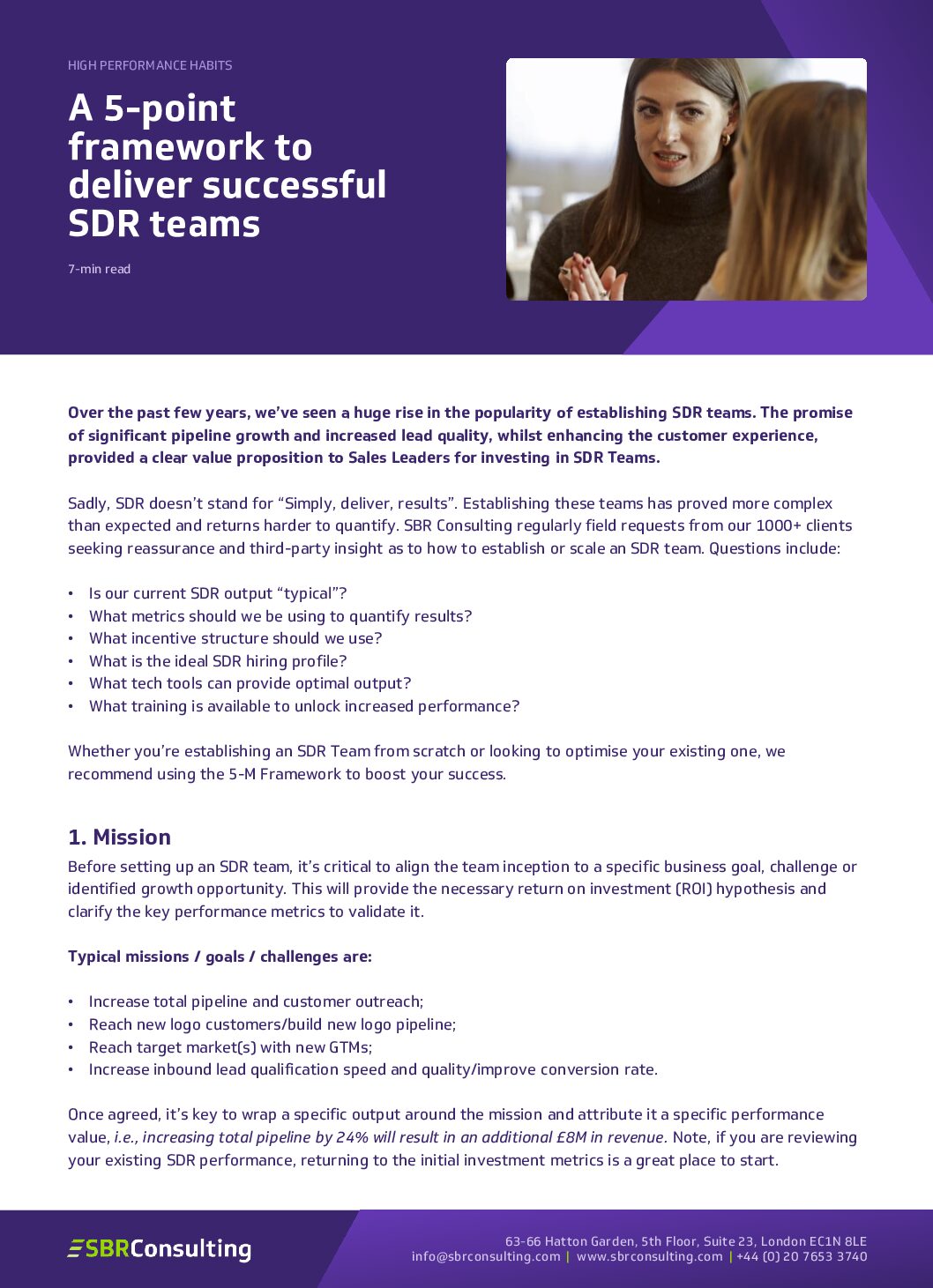
High performance habits
A 5-point framework to deliver successful SDR teams
7 min read
Over the past few years, we’ve seen a huge rise in the popularity of establishing SDR teams. The promise of significant pipeline growth and increased lead quality, whilst enhancing the customer experience, provided a clear value proposition to Sales Leaders for investing in SDR Teams.
Sadly, SDR doesn’t stand for “Simply, deliver, results”. Establishing these teams has proved more complex than expected and returns harder to quantify. SBR Consulting regularly fields requests from our 1000+ clients seeking reassurance and third-party insight as to how to establish or scale an SDR team. Questions include:
- Is our current SDR output “typical”?
- What metrics should we be using to quantify results?
- What incentive structure should we use?
- What is the ideal SDR hiring profile?
- What tech tools can provide optimal output?
- What training is available to unlock increased performance?
Whether you’re establishing an SDR Team from scratch or looking to optimise your existing one, we recommend using the 5-M Framework to boost your success.
1. Mission
Before setting up an SDR team, it’s critical to align the team inception to a specific business goal, challenge or identified growth opportunity. This will provide the necessary return on investment (ROI) hypothesis and clarify the key performance metrics to validate it.
Typical missions / goals / challenges are:
- Increase total pipeline and customer outreach;
- Reach new logo customers/build new logo pipeline;
- Reach target market(s) with new GTMs;
- Increase inbound lead qualification speed and quality/improve conversion rate.
Once agreed, it’s key to wrap a specific output around the mission and attribute it a specific performance value, i.e., increasing total pipeline by 24% will result in an additional £8M in revenue. Note, if you are reviewing your existing SDR performance, returning to the initial investment metrics is a great place to start.
As the business matures and faces different challenges, the SDR mission may need to evolve. However, it will remain essential to maintain focus on the ROI and expected performance outputs.
2. Management
Once the mission is established, deciding where the SDR Team will live in the business is the next step. Typically, SDR teams live either in the Sales or Marketing organisations, but they can live in Customer, Product or Enablement teams as well. The recommended approach is to align the SDR Management to the mission. So, if the business goals are inbound lead-oriented, then Marketing may be the best reporting line. On the flip side, if outbound pipeline growth is the focus, alignment to Sales leadership may be the prime solution.
If your SDR team does both inbound and outbound, then ensure you have exact clarity on the work breakdown, and prioritise their mission and how the SDR team will report success to their various stakeholders. Serving too many masters (inbound vs. outbound) is a typical challenge that SDR teams face, so alignment with the most appropriate management team is key.
Day-to-day management should ideally fall to an experienced SDR leader – one with experience building and scaling multiple SDR (or similar) teams and who understands the necessary evolution. Successful SDR management requires the right balance of operational excellence to scale the team and tactical prowess to deliver the broader sales strategy. Investing in external talent can offer invaluable support when creating the Org Design, compensation, hiring and tech stack strategy, as well as validating the optimal approach to achieve the mission.
3. Momentum
Regardless of Mission and Management, businesses can make a fatal error when building an SDR team by not focusing on Momentum. Creating a successful SDR team will likely take several revisions and go through many iterations. You are aiming for progress, not perfection (see the continuous improvement wheel). Start, fail, learn, iterate, and build momentum. SDR teams have to create capacity, building habits, systems and momentum before results.

Sales development representative is a role that benefits from tenure, exposure and experience. Ensure the necessary training is in place so as not to risk reputational damage in the marketplace and get your team operational.
The experience of creating a 1000-person outreach campaign with a 1% response rate is a key part of the learning journey to creating a 50-person campaign with a 25%+ response rate. Build successful habits, expectations, capacity, and momentum, then focus on the quality of the output.
4. Measurement
SDR success measurement will likely evolve with the team, transitioning from volume to quality, before landing on the focus that achieves the original mission. This evolution could look like this:
- Expected #calls or #e-mails
- Volume of SQL/MQLs created
- Quality Meeting Completed (QMC)
- #Opportunites created
- Value of pipeline created (£)
- #Deals Closed
- Value of deals closed
For inbound workflow, the measurement could focus on MQL conversion, quality, and speed as well as “time of touch” efficiencies.
Benchmarking expected outputs can be challenging and vary drastically between industry sectors and geographies. Using external consultants with experience in enabling SDR teams across multiple regions and sectors can help unlock optimal performance.
“When I had to scale a team of Sales Development Reps globally, SBR helped create the strategy to position this team and trained them to create value in the broader sales org.”
Arafat Mir Global Sales Development Leader S&P Global Market Intelligence
5. Mobility
Talent retention is a critical success factor for SDR Management. Following the initial 3-6 month ramp time, the path to mastery for an SDR is short. Top performers will often quickly start to push for moves into more lucrative junior sales or account executive positions. While SDR teams can create excellent talent feeders into these roles, it is essential to curate this mobility journey.
We recommend creating a 3-year “hire to AE” (or introductory quota-carrying role) pathway that includes training, certifications, progression, pay increases and clear performance outputs. Without constitutionalising the SDR role, mapping exactly what’s expected and how they fit into the wider sales ecosystem, companies run the risk of role dilution, confused customer experience, talent attrition and a decrease in total sales output.
Summary
“Simply deliver results” isn’t a strategy for establishing or scaling an SDR team. SDRs can play a vital role in accelerating pipeline growth, enhancing lead processing, and delivering significant sales growth. They can also, in the absence of a well-executed strategy, be an investment that negatively impacts both bottom and top-line sales performance.
Whether you’re establishing, scaling or reviewing your SDR team, the 5-M Framework provides the foundation to support your SDR journey.
To discover more about scaling your business, let’s talk growth.



